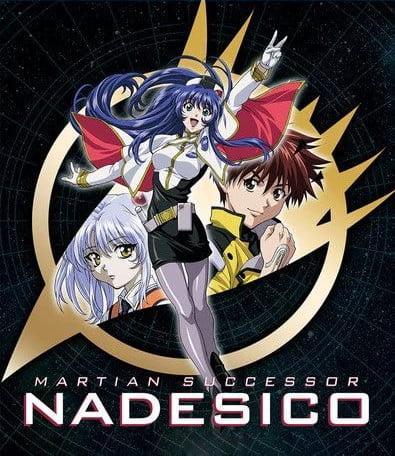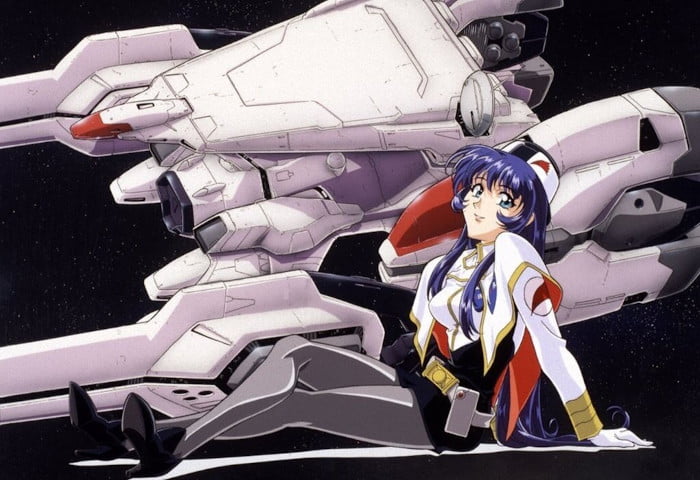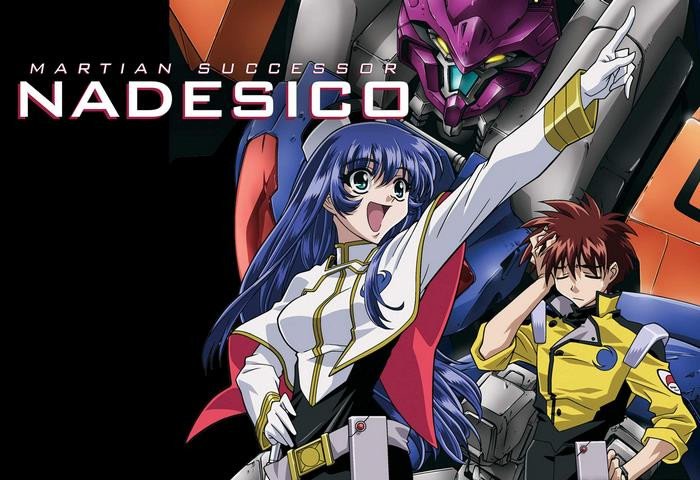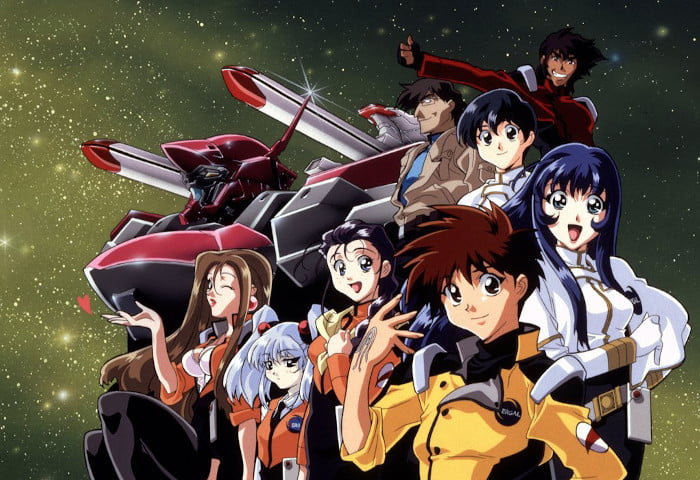Martian Successor Nadesico is a comedy-drama science-fiction space opera story with an enormous cast of characters that introduces a spaceship, recruits its screwball crew, goes to mars, then to the moon, engages in multiple sorties, defies the UN, deals with shadowy secret research, uncovers a conspiracy, grapples with questions of culture and media, wins a war, creates a peace, has a talent contest, multiple music videos, love triangles that go through the full typical mathematical configurations, is funny as hell and serious as a heart attack.
This popcorn anime of the late 90s is now a vintage classic.
The world was a different one, where anime were not being wholly produced on computers (yet), nor the natural end point for a churning industry of marketable light novels (yet), nor an endless filler spiral trying to maintain the presence of one of the big three shounen anime in the minds and charts of the viewing public (yet). It was a time when anime series were seriously grappling with just being too big to reasonably buy, where a 13 episode anime would still cost you $140 to buy, because you’d get two episodes per VHS tape, and each tape would cost you $20 AUD.
You had to pick dubbed or subbed when you bought the tape, and it was entirely possible that the track you wanted wouldn’t be available when you went to the store. An anime might sell out of like, volume 6 in sub or dub, and you had to wait literal years for the next reprinting.
It was a time when the medium was the message in a truly astounding way: when anime was competing for a small number of slots, for a small audience, and as a result, it was even more self-referential, trope-codifying and quietly impenetrable than you’d imagine. Right now, the main anime people know from this time, and I say ‘know’ in that they ‘kinda remember’ or ‘have watched some of,’ or think about it as a thing that’s important to ‘anime,’ is Evangelion or Pokemon, which you can definitely look at as two forking paths: one of mass-market popularity, and one of deliberately reflective genre awareness.
It’s one thing to be a leader. It’s another thing to be one of the first followers.
And it’s even more impressive to somehow follow both.
SPOILER WARNING: Uh, spoilers? Some? For stuff in the series that is why you should want to check this anime out?
The story of Martian Successor Nadesico is very large if you want to try and summarise all of it and very simple if you just want to know why you should tune in week to week. There’s a boy named Akito, who has had a difficult childhood and wants to be a cook. He’s also been recruited as part of a Best Of The Best program to serve as a super-powered mecha pilot on the ND-001 Nadesico, a privately-constructed military-grade superweapon that’s being deployed to Mars in the war against The Jovian Lizards. Of course, that descriptor brings with it a host of tightly-packed questions unanswered, too.
Great, easy, this is classic space opera thing. Then you learn that in addition to the privately-owned spaceship that recruited the Best of the Best did so despite what the military would consider ‘personality defects,’ which include things like being oppositional, propensity for flights of fancy, terrible social skills, intense PTSD, and their tool for dealing with the Jovian lizards is the Aestivalis, a cool mecha with upgrade kits and transformations. We’re introduced to these with the character of Jiro Yamada, who then immediately demands to be addressed as Gai Daigoji (and you should), as he shows the series its secondary framing device and recurrent motif palette, the retro 80s style cheaply made Giant Robot TV series for chidlren, GEKIGANGER 3.
That means we must be dealing with a goofy rollicking space opera adventure with a lot of self awareness and dramatic over the top moment and a tropey nod-wink we’re-here-for-the-memes attitude, right? We’re gunna watch mecha battles and proud boasts and raised fists and alien invaders, right?
Anyway, then an ordinary military operation shoots Gai in the chest in an undignified little death that sends his new best friend into a deeply depressed shock.
At this point the story of Nadesico shows what it’s doing: Yes, it’s a very self-aware, genre-focused version of its narrative, but it’s not here to fuck around. The story of Nadesico is about the entire arc of the space opera narrative, and the ways that narrative has problems, and it’s at this point, with the death of Gai that the series shouts WE KNOW at every one of its ridiculous tropes.
Why is the captain a cute girl who doesn’t seem to do much captaining? She’s a figurehead meant to inspire confidence. Selecting a new captain at one point is presented as an idol competition. Why are the characters on this vessel both extremely expert in their fields, but not military-grade? Mostly because of past experiences making them incompatible with the military. Why do the aliens behave in a way that makes sense as the villains of a TV show?
All of these questions have answers, they have reasons, and answering them creates more narrative space.
I said this series followed in the footsteps of both Pokemon and Evangelion, so to explain: Evangelion took the genre of the Giant Robot story and did a lot to put the premises of those stories front and centre in its worldbuilding, to tell a story about how good it would be for you, personally, to go outside and make a friend, yes, even though that’s hard. Pokemon was the most heavily merchandised anime of its time, resulting in a design you might see as ‘Toyetic.’ Everything in a Pokemon world was clearly branded and could be made into a thing.
Nadesico definitely took the Pokemon visual aesthetic to heart. Multiple mecha designs, spaceship designs, figurines of a big cast of characters, toys of the show within the show, and all sorts of things that they never even made toys out of. As corporate entities, everything in Nergal’s purview had its own branding marks, its own aesthetics, and those things could be seen everywhere and in how the merchandisable things were presented.
The way this series drew from Evangelion, though was how it took the same reluctant hero characterisation of Shinji Ikari in its protagonist Akito, and ask the questions of why would someone do this and then what would change a character to generate a story. But instead of focusing on the tropes of Giant Robot stories like Evangelion did, Nadesico did it with the tropes of the self-aware anime, by including its own anime inside it, and then showing you a world that reflected what the audience of an anime that failed to grow or mature would become.
The series is certainly built for someone like me.
It’s a space epic, but it’s short; not a full speed-run of the genre, but its full run is about as long as single seasons of other, weightier space epics. Even Robotech has its seasons run ten longer than the entire narrative arc of Martian Successor Nadesico, which goes from ‘people on earth’ to multiple phases of the war and changes of power well before it even introduces you to the aliens. It cast is big, and varied, and it’s shockingly light on filler material even as it’s jam packed to the gills with lots of incidental material. It even manages to use its clip show episode well, showing what was or wasn’t important in the series up to that point for new viewers. It even makes good jokes that are unique to a clip show episode!
The characters are varied, so even if one or two of them bug you, there’s a lot of alternatives to pay attention to. Most characters who are bad people don’t try and redeem themselves from it, and it’s seen as that a character can be interesting but also bad, that being interesting isn’t forgiveness for awfulness. There’s a fairly wide variety in the way characters look, too, though women get more visual variety and dudes all do collapse around a few basic points (and are all kinda tedious in the same ways). Combat is fast and decisive and there’s a lot of examination of the infrastructure of war, of what training is worth.
The main character is a grounded human with an existing interest and the stress of combat on him is shown in contrast to the actual PTSD he also has. Love triangles aren’t overwhelming and characters have reasons to express attraction to the people they’re into.
Oh, and a large part of the narrative is about the way media we indulge in for comfort shapes our view of reality itself, with a giant flaring message about how, say, replicating narratives of adventure stories from our past could involve replicating vast systems of things like misogyny and racism.
If you wanted to give me, personally more different handles to use as tools to examine a narrative, it would be hard to find an anime more densely packed with them. Hell, it’s a 90s anime and it’s available on youtube for free.
In the process of asking and answering its own questions, then, Nadesico introduces you to a surprisingly consistent narrative that usually asks a question, then actually addresses them. What values does our media instil in us? Is there a reason to respect the military? Is there a reason to respect corporations? Is pacifism itself, an inherent good? What would you do if you were bossed around by a child that thanks to time travel you were now confronting as an adult? Okay, that one’s a little less applicable.
What surprises me, on a rewatch, is that Nadesico is not just a better series than I thought, but that it had a really consistent ethical framework that it seemed to spend its time repeating. A, or B? Well, C, but let’s show you the problems with A and B. What kinds of things do you see presented as villains? Nobility, inherited wealth, military power for its own sake. What do you see as worth keeping? Found family, the people you choose to love more than the people you’re told you’re obligated to love.
But why did I rewatch it?
This opening theme has been singing back and forth in my head for twenty years.
It’s one thing when an anime has a banger of an opening, sure, that’s impressive, and some anime have multiple openings, but what anime do you know that have a banger opening for the show within a show that the characters watch?
The heart of Martian Successor Nadesico is an anime made about anime for people who love anime at a time when they knew that they could sit down, very seriously, and talk to an audience who knew what to expect, and use those expectations to disarm and disable them.
Is it perfect? God no. No, there’s annoying cooking subplots, the romance triangle is frustrating as hell, series doesn’t handle queerness well at all, and for all that the central premise has giant flaring red letters reading YOUR FAVOURITE ANIME WAS SHITTY AND MISOGYNIST SO BE BETTER doesn’t mean that it doesn’t still step into a bunch of cowpats on the way to that message.
But it knows what it cares about.
It’s got an idea at the heart of it.
And it expresses that idea through aggressive, energetic, fast-paced science fiction space opera that is both extremely aware of how it exists and incredibly cynical about how good a thing that is.




